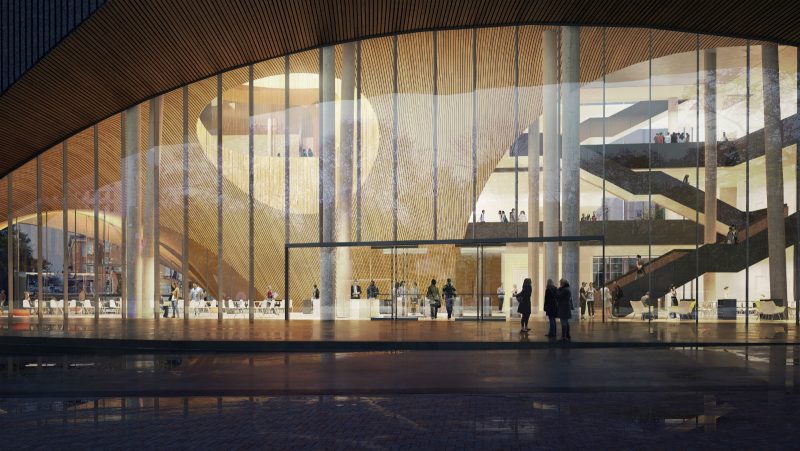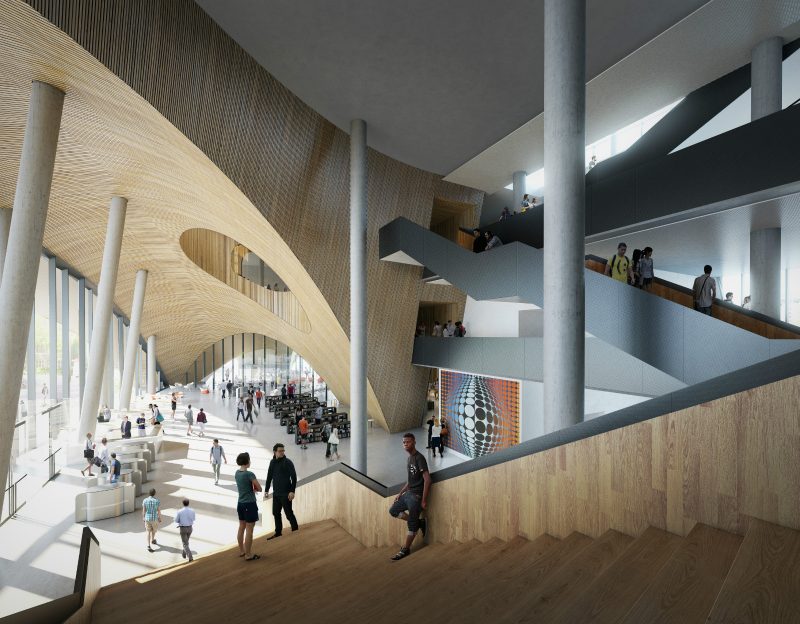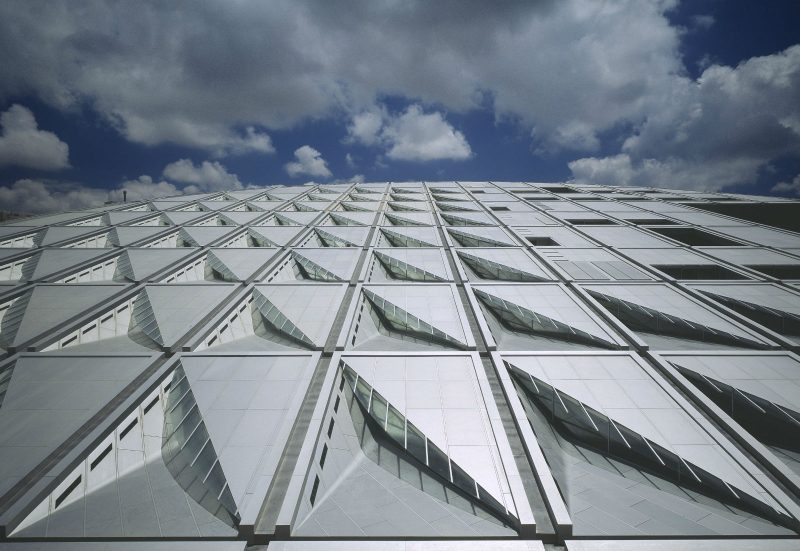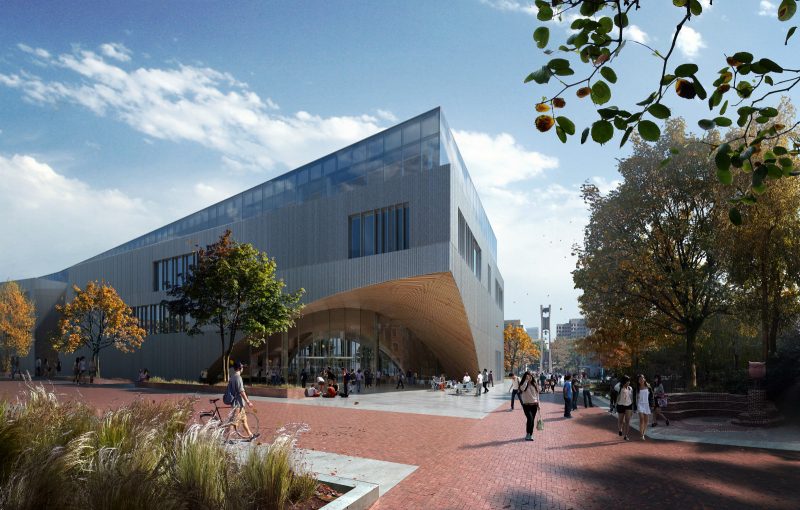“Architecture is inhabited sculpture.”
—Constantin Brancusi

Few institutions so clearly embody the idea of civilization as does a library. No matter where you are in the world, libraries are cherished spaces of learning where scholars meet and children are transformed. It has been that way since the mid-fourth century BC, when the ancient city of Alexandria, Egypt, established a library for its 400,000 or so treasured texts and became the most significant library of the ancient world. Libraries are registries of our past, and within their hallowed walls we must mine that past to promote the public good.
In 2018, Philadelphia will become home to a library-of-the-future, the new Temple University Library, designed by Snøhetta, a collective of architects, landscape architects, and designers world-renowned for their community-focused methodology.
How apt it is that this library designed for the people and by the people will stand in the first capital of the United States. After all, Philadelphia owns bragging rights to the first “free” library in the country–free, that is, to its dues-paying members whose subscriptions financed the library’s book purchases. This “free” library was founded by Ben Franklin in 1731. In 1891, the (truly) Free Library of Philadelphia was chartered as “a general library which shall be free to all” through efforts by Dr. William Pepper, who tapped his wealthy uncle George S. Pepper for $225,000 to get things rolling. Today, the Free Library of Philadelphia system is the 13th largest system in the country with a 2015 budget of $48 million, operating at 61 locations, including 3 regional libraries, 49 neighborhood libraries, 5 community Hot Spots, the Rosenbach Museum and Library, and much more. (In addition to the Free Library there are legions of specialized, school, and university libraries in Philadelphia).
A doozy of a sculpture to inhabit

Inspired by the academies of ancient Greece and Byzantium, the new Temple Library is designed to create pleasurable–and hence optimal–learning experiences. The visual anchor of the building will be an updated take on a characteristic element of Classical architecture–the oculus, a round opening centered in the dome of a building. Like a latter-day Roman Pantheon, the new Temple library will have a giant oculus in the center of its 3-story atrium that will allow natural light to permeate the 225,000 square-foot structure and orient visitors no matter where they are inside the building.
The idea to center the library on the interior of the campus instead of bordering the campus’ western edge was conceived by Dr. Neil Theobald when he became Temple University’s president in 2012. This April, associate vice president Margaret Carney revealed at a panel discussion at Temple that planning for the library had been underway for five years when Dr. Theobald came on board, walked the campus, and had a different vision for the library’s placement. His objective was that the new library be smack dab in the middle of the campus. Once inside the building (which right now is a square block hole at 13th Street and Polett Walk), you will be able to see across campus from every direction through windows facing north, south, east and west, as well as up into the sky through the oculus in the ceiling.
Outside, the design calls for a large grassy park or quadrangle that will give Temple campus an epicenter for the first time, and will give its north Philadelphia neighborhood a monumental sculptural building. Plus, Philadelphia’s world class library conglomerate will get a 21st century architectural gem to complement the grand Beaux-Arts building from which the Free Library of Philadelphia has reigned atop Logan Circle since 1927.
From the exterior, the library’s dominant feature will be another update on a Classical form–the triumphal arch. This monumental arch will simultaneously awe and welcome. Smaller though still large arches eyebrow tall windows and carry on the arch design.
Driven by their conviction that people create knowledge in social environments and through social contact, the Temple/Snøhetta team designed a library with a variety of places to meet ranging from large, raucous and public to small, quiet and private. The building will contain a Center for Learning and Success, a Writing Center, a coffee shop, and places for study available 24/7. The knowledge embedded in 90% of Temple’s 2,000,000 books, periodicals, and DVDs will be easily accessed by Temple students and faculty from every nook in the library via its automated quick book retrieval system, known as the BookBot. Students, faculty and the public can access the BookBot system via the internet from off campus and retrieve their book at a campus location. Ten percent of this stockpile of Temple-owned knowledge will be right there in material form to browse and see and read in the light-flooded top floor. Now, if that is not literary heaven on earth, what is?
Though automated book retrieval has been around for well over a decade, the idea of installing a super-duper automated book system in the new Temple Library to save space occupied by Temple’s beloved stacks was hotly contested among academics, particularly if they grew up wandering the stacks and inhaling the smell of books. It is a change that goes down hard.
Temple and Snøhetta listened with wide open ears as old-time academics aired their perspectives and tweaked and tweaked the design to assuage the metaphysical crisis these long time scholar/philosophers were experiencing as reality set in: most of the 2 million books and periodicals and DVD covers will rarely be touched or seen or in their physical form again.
Snøhetta’s libraries without books

In 1989, Snøhetta designed the Bibliotheca Alexandrina, a postmodern echo of the incomparable Alexandria library. Alexandria, the heart of culture and commercial crossroad in ancient Egypt, is most famous for having had the irreplaceable volumes housed in its library destroyed during the reign of Julius Caesar in the first century BC.
In the Bibliotheca Alexandrina, Snøhetta installed state of the art technology to bring knowledge of the world, both past and present, to those who come to the library as well as everybody else who has internet access. Though this whirring technology offers no replacement for the tactile thrill of unrolling its predecessor’s acclaimed stock of ancient scrolls, the new Alexandria Library does offer a vastly more complete record of history from ancient times to the present, which its technology updates continuously.
Most importantly, the history of the Alexandria Library as a sanctuary of civilized communication and political power lives on in Snøhetta’s designed public and private spaces for people to meet and exchange ideas. And so it was that during the 2011 Arab Spring uprisings, when cultural sites and institutions in Egypt were being looted and burned, the people of Alexandria circled the library to protect it. They were not about to allow their library to be burned or looted. Indeed, the building and its contents were untouched.
Let’s watch Temple’s library construction this fall and imagine …

In the 1960s, Marshall McLuhan taught my generation that the medium is the message–that is, form and content are inextricably linked, shaping one another. From McLuhan’s perspective, the new Temple Library reflects an enlightened shift in form, and a nuanced update in the meaning and purpose of libraries. A McLuhan groupie, I cannot wait to read in the naturally lit top floor and look through the oculus up to the sky.
Historians of the book like Stephen Greenblatt and other followers of New Historicism have argued that the creation of knowledge is embedded in its material forms. Some may argue that the new Temple Library’s 21st century technological shift is as radical as the transition from papyrus scroll to bound codex in the third and centuries centuries AD, or from manuscript to print in the 15th century–and perhaps not for the public good.
Since only hindsight will tell and attempts to forecast the future are notoriously unsuccessful, for now I look at Snøhetta’s beautiful renderings and visualize the splendid building. Come fall, I will watch its construction, and fancy what it will be like to chat about art with my friend Temple Professor Nora Alter in the café.
Thank you to Flora Ward for her perspective.
FOOTNOTE
**Dr. Theobald resigned as President effective August 1, 2016, after a dispute with the Board of Trustees. He will be replaced by Richard M. Englert, a longtime university administrator, who will be acting president.









